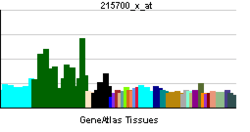CPNE6
| CPNE6 | ||||||
|---|---|---|---|---|---|---|
| Identifiers | ||||||
| Aliases | CPNE6 | |||||
| External IDs | MGI: 1334445 HomoloGene: 81815 GeneCards: CPNE6 | |||||
| RNA expression pattern | ||||||
  | ||||||
| More reference expression data | ||||||
| Orthologs | ||||||
| Species | Human | Mouse | ||||
| Entrez | ||||||
| Ensembl | ||||||
| UniProt | ||||||
| RefSeq (mRNA) | ||||||
| RefSeq (protein) | ||||||
| Location (UCSC) | Chr 14: 24.07 – 24.08 Mb | Chr 14: 55.51 – 55.52 Mb | ||||
| PubMed search | [1] | [2] | ||||
| Wikidata | ||||||
| View/Edit Human | View/Edit Mouse |
Copine-6 is a protein that in humans is encoded by the CPNE6 gene.[3][4]
This gene encodes a brain-specific member of the copine family, which is composed of calcium-dependent membrane-binding proteins. The gene product contains two N-terminal C2 domains, and one von Willebrand factor A domain. It may have a role in synaptic plasticity.[4]
References
- ↑ "Human PubMed Reference:".
- ↑ "Mouse PubMed Reference:".
- ↑ Nakayama T, Yaoi T, Yasui M, Kuwajima G (Jul 1998). "N-copine: a novel two C2-domain-containing protein with neuronal activity-regulated expression". FEBS Lett. 428 (1–2): 80–4. doi:10.1016/S0014-5793(98)00497-9. PMID 9645480.
- 1 2 "Entrez Gene: CPNE6 copine VI (neuronal)".
Further reading
- Maruyama K, Sugano S (1994). "Oligo-capping: a simple method to replace the cap structure of eukaryotic mRNAs with oligoribonucleotides". Gene. 138 (1–2): 171–4. doi:10.1016/0378-1119(94)90802-8. PMID 8125298.
- Suzuki Y, Yoshitomo-Nakagawa K, Maruyama K, et al. (1997). "Construction and characterization of a full length-enriched and a 5'-end-enriched cDNA library". Gene. 200 (1–2): 149–56. doi:10.1016/S0378-1119(97)00411-3. PMID 9373149.
- Nakayama T, Yaoi T, Kuwajima G (1999). "Localization and subcellular distribution of N-copine in mouse brain". J. Neurochem. 72 (1): 373–9. doi:10.1046/j.1471-4159.1999.0720373.x. PMID 9886090.
- Nakayama T, Yaoi T, Kuwajima G, et al. (1999). "Ca2(+)-dependent interaction of N-copine, a member of the two C2 domain protein family, with OS-9, the product of a gene frequently amplified in osteosarcoma". FEBS Lett. 453 (1–2): 77–80. doi:10.1016/S0014-5793(99)00700-0. PMID 10403379.
- Caudell EG, Caudell JJ, Tang CH, et al. (2000). "Characterization of human copine III as a phosphoprotein with associated kinase activity". Biochemistry. 39 (42): 13034–43. doi:10.1021/bi001250v. PMID 11041869.
- Strausberg RL, Feingold EA, Grouse LH, et al. (2003). "Generation and initial analysis of more than 15,000 full-length human and mouse cDNA sequences". Proc. Natl. Acad. Sci. U.S.A. 99 (26): 16899–903. doi:10.1073/pnas.242603899. PMC 139241
 . PMID 12477932.
. PMID 12477932. - Ota T, Suzuki Y, Nishikawa T, et al. (2004). "Complete sequencing and characterization of 21,243 full-length human cDNAs". Nat. Genet. 36 (1): 40–5. doi:10.1038/ng1285. PMID 14702039.
- Gerhard DS, Wagner L, Feingold EA, et al. (2004). "The Status, Quality, and Expansion of the NIH Full-Length cDNA Project: The Mammalian Gene Collection (MGC)". Genome Res. 14 (10B): 2121–7. doi:10.1101/gr.2596504. PMC 528928
 . PMID 15489334.
. PMID 15489334.
This article is issued from Wikipedia - version of the 6/6/2016. The text is available under the Creative Commons Attribution/Share Alike but additional terms may apply for the media files.